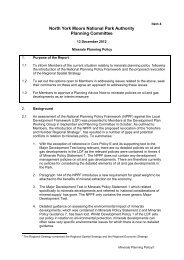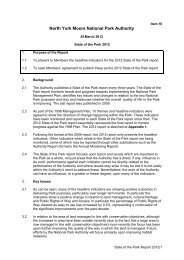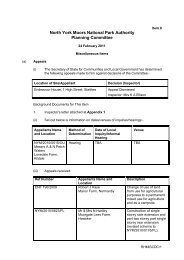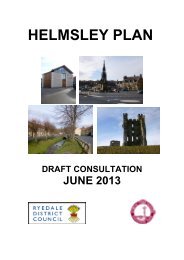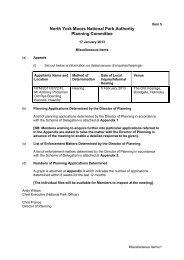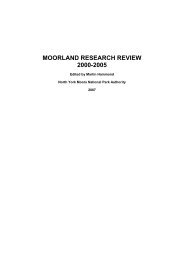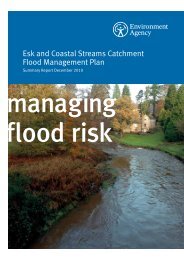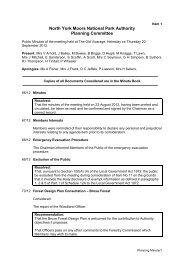Management Plan - North York Moors National Park
Management Plan - North York Moors National Park
Management Plan - North York Moors National Park
Create successful ePaper yourself
Turn your PDF publications into a flip-book with our unique Google optimized e-Paper software.
Communities5.6 EnergyThe businesses, residents and visitors to the <strong>National</strong> <strong>Park</strong> all useenergy – for electricity, for heating and for transportation. Thereare some particularly large energy users in the <strong>National</strong> <strong>Park</strong>,specifically Boulby potash mine and Fylingdales early warningstation. This use of energy results in the release of CO 2 emissionswhich are leading to changes in the climate. Transport accountsfor nearly half of all emissions, industrial and commercial foraround a third and domestic around 20%.To put the level of emissions into perspective, if every farm inthe <strong>National</strong> <strong>Park</strong> had a 6kW wind turbine and every house hadphotovoltaic panels this would offset the <strong>National</strong> <strong>Park</strong>’s CO 2emissions by less than 4%.As well as resulting in emissions of greenhouse gases, energy usealso has a financial cost to the consumer. In 2009, it is thoughtthat around 20% to 30% of households in the <strong>National</strong> <strong>Park</strong> werein fuel poverty 73 .Reducing energy use and generating energy from sustainablesources will help to address issues of fuel poverty and offsetsome of the damage being caused by emissions, but it must beacknowledged that efforts must be made globally to have anyreal effect. It is considered that the <strong>National</strong> <strong>Park</strong> can becomean ‘exemplar’ in creating opportunities for energy generationthrough wood fuels, micro-hydro, anaerobic digestion andwind and solar power installations appropriate to the nationalvalue of the landscape, whilst at the same time reducing its ownemissions.In recent years, efforts have been made to reduce energy use inthe <strong>National</strong> <strong>Park</strong> and to use the <strong>National</strong> <strong>Park</strong>’s natural resourcesto generate sustainable forms of energy. The <strong>National</strong> <strong>Park</strong>Authority’s Community Renewable Energy Project supportedcommunities in the Esk Valley and Appleton and Spaunton byproviding funding and support for the community to implementenergy efficiency measures and develop renewable energyschemes, including the development of a 50kW hydroelectricscheme on the River Esk at Ruswarp. Outside of this project,a range of renewable energy schemes have been installed inlocations across the <strong>National</strong> <strong>Park</strong> including domestic scale windturbines, solar hot water and photovoltaic panels, biomass boilers,air and ground source heat pumps and hydro energy schemes.Further, all of the Forestry Commission’s surplus timber goesto SembCorp on Teesside where it is used to generate energy.Nevertheless, it is considered that a great untapped potential stillexists in the <strong>National</strong> <strong>Park</strong>.Probably the easiest way to reduce CO 2 emissions is to simplyuse less energy, which will leave no visual impact upon the<strong>National</strong> <strong>Park</strong>, has no upfront costs and will lower energy coststo the consumer. Energy efficiency measures can help with thisand many buildings in the <strong>National</strong> <strong>Park</strong> already accommodatea range of these such as double or secondary glazing, loftinsulation and draught proofing, but it is considered that thereis potential to do a lot more. Wasting less energy and installingenergy saving measures could save around a third of the <strong>National</strong><strong>Park</strong>’s domestic CO 2 emissions.The importance of using less energy is clear when it is consideredthat to offset all of the CO 2 emissions in the <strong>National</strong> <strong>Park</strong> wouldrequire, for example, over 90,000 6kW wind turbines or nearly500,000 PV panels. Nevertheless, there is a role for expandingthe use of renewable energy in the <strong>National</strong> <strong>Park</strong>. It is consideredthat, provided they are installed in appropriate locations, acombination of domestic scale wind turbines, solar panels (bothPV and solar hot water), ground source heat pumps, air sourceheat pumps, wood pellet boilers and farm based hydropowerschemes, along with increasing the use of energy efficiencymeasures and using less energy, could offset all of the <strong>National</strong><strong>Park</strong>’s domestic CO 2 emissions. Domestic emissions account foraround 20% of the <strong>National</strong> <strong>Park</strong>’s CO 2 emissions.Whilst wind and solar technologies can clearly make animportant contribution, it is considered that a great deal ofpotential exists for the use of air source and ground source heatpumps and wood fuel, all of which can have little or no impactupon the <strong>National</strong> <strong>Park</strong>’s special qualities. In particular, woodpellet boilers installed in half of the <strong>National</strong> <strong>Park</strong>’s dwellingscould offset more than 10% of the <strong>National</strong> <strong>Park</strong>’s total CO 2emissions. Take up of wood fuel may also provide an impetusto put some currently unmanaged private woodlands into use.In addition to the potential for some medium scale hydropowerdevelopment on the River Esk, there are a number of farmswhich have water courses that could accommodate a small scalehydropower installation.Many small scale renewable energy installations now benefitfrom Permitted Development rights, meaning that they do notrequire planning permission. Take up of renewable energy isoften driven by subsidies, and therefore future funding schemesare likely to largely dictate the amount and type of renewableenergy that comes forward in the <strong>Park</strong>.73 Based on Department of Energy and Climate Change statistics forHambleton District, Redcar and Cleveland Borough, RyedaleDistrict and Scarborough Borough Councils, 2009)112 www.northyorkmoors.org.uk




